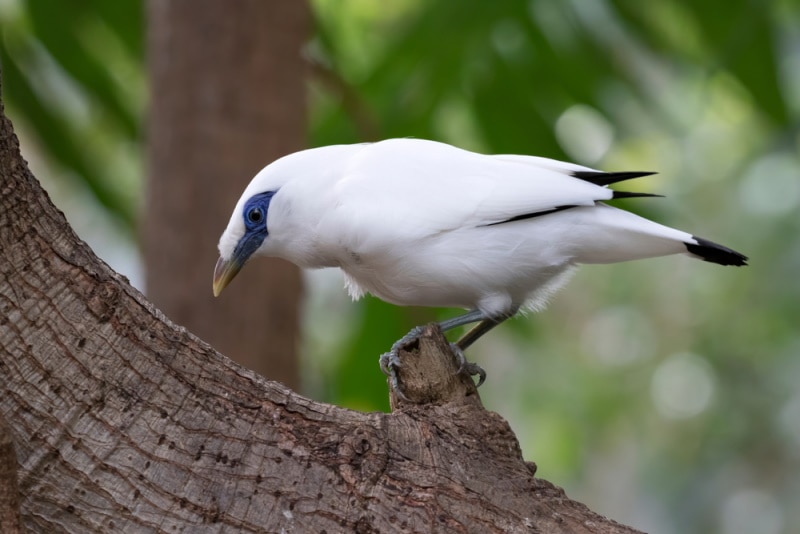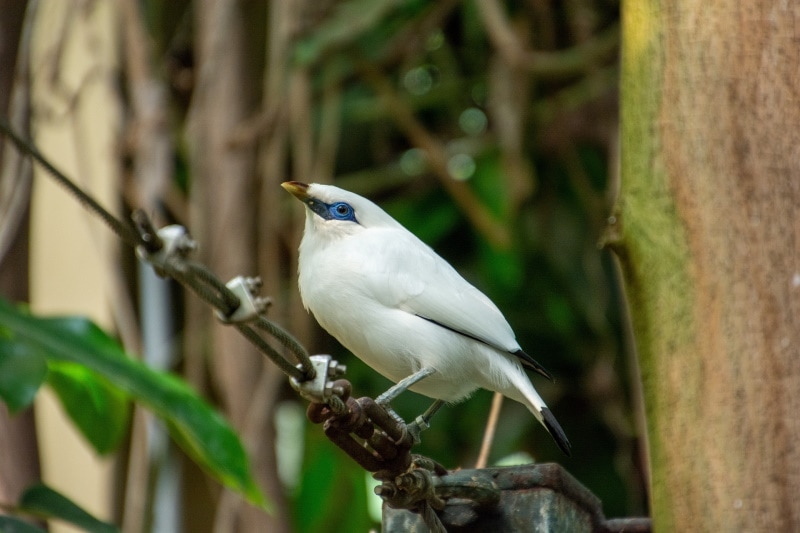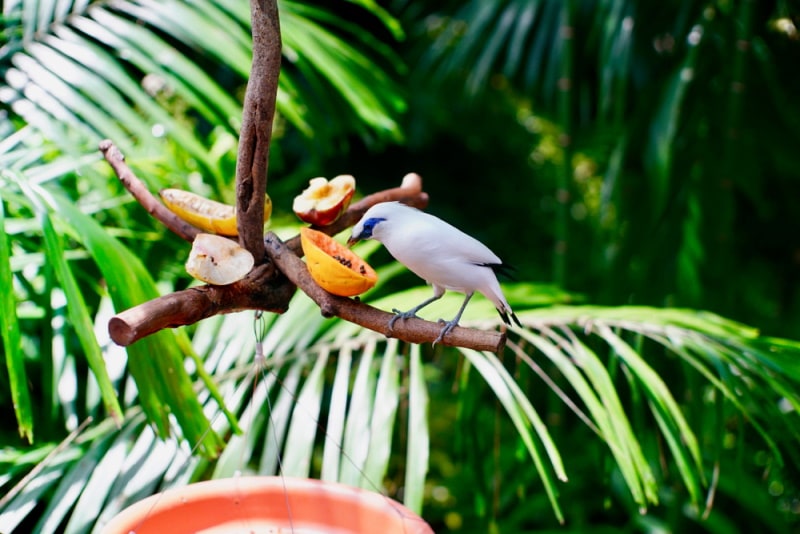Bali Myna (Bali Starling): Field Guide, Pictures, Habitat & Info
Last Updated on

The Bali Myna is a beautiful and mysterious bird native to Bali, Indonesia, where it is the island’s only endemic vertebrate species. With a coat of white feathers covering most of its body and striking blue rings around its eyes, the bird is featured in several of Bali’s art collections.
Its rarity and endemic status, combined with its striking beauty and melodic voice, caused its value to rise to hundreds of millions of rupiahs. The rapid deforestation of the Bali Mynas’ limited habitat was the final straw that led the bird to critical endangerment.

Quick Facts about the Bali Myna (Bali Starling)
| Habitat | Bali, Indonesia |
| Diet | Insects, fruit, small worms, and reptiles |
| Behavior | Friendly and found in large groups |
| Nesting | Holes of trees |
| Conservation | Critically endangered |
| Scientific name | Leucopsar Rothschildi |
| Lifespan | 5- 15 years |
Bali Myna (Bali Starling) General Description
The Bali Myna is a stunning white bird with a long, drooping crest and black tips on its wings and tail. The bird has bare skin around the eyes that is blue, greyish legs, and a yellow bill. The male and female are nearly identical, with the exception of a slightly longer delicate, lacy head crest extending down the back of the neck on the male. They measure 10 inches long, and their weight is between 2 and 4 ounces.
It is critically endangered, with fewer than 100 adults thought to exist in the wild.

Bali Myna (Bali Starling) Range, Habitat, Behavior, Diet & Nesting
Range
The Bali myna is indigenous to Indonesia. The total area of the range is less than 65 square kilometers and has never been abundant due to its limited range. They were once found throughout the island but are now only located in the Bali Barat National Park.
Habitat
Bali Mynas are the national bird of Bali and live in the mountains along Bali’s north coast. They live in the woodlands, tree savannas, deciduous forests, and occasionally in coconut groves.
Behavior
Bali Mynas are very friendly birds; when not breeding, they will form large groups of 30-60 birds. Males are highly aggressive when breeding: raising their white crests and bobbing their heads to attract a mate. Allopreening (cleaning each other’s feathers) is also practiced by Bali Mynas.
Diet
Bali Mynas are omnivores. They feed on seeds, fruits, insects, worms, and small reptiles. Most of their foraging takes place in the trees. It is usually during the chick-rearing season when they are seen on the ground.

Nesting
They build their nests in cavities, which are frequently dug by barbets and woodpeckers and are usually lined with plant stems, leaves, and feathers. Breeding occurs during the rainy season when both fruits and insects are abundant. It is believed that two, possibly three, clutches are laid during the breeding season.
How to Find a Bali Myna: Birdwatching Tips
The Bali Myna can currently be found in three locations in Bali: The West Bali National Park, the island of Nusa Penida, and the Begawan Foundation’s breeding site at Sibang, adjacent to Green School.
What to Listen For
mynas are known to chatter while in flight, and they squawk, whistle, and bob their heads up and down. They make a “creer” sound as they take off. The sound of their alarm is “tschick, tschick, tschick.”
What to Look For
Except for the black tips on the tail and wing feathers and a patch of blue skin around the eyes, the Bali myna is all white. It has a small crest on its forehead and a rounded tail.

When to Look
The birds are typically found in flocks of 20 to 30 in areas not already occupied by other types of Starlings. They breed between November and April, which is Bali’s rainy season. The entire Bali Myna population usually congregates in a 740-acre section of Bali Barat National Park to breed.
Attracting Bali Mynas to Your Backyard
Bali Mynas are critically endangered, and their range is restricted to the Bali Barat National Park, where the birds are guarded by armed personnel. The Indonesian government is protecting the remaining wild birds and working on returning the population to its original numbers through reintroductions and post-release monitoring.
Today, the Bali Bird Sanctuary, which encompasses the Nusa Penida Island group, is home to more than 100 Bali Starlings, having successfully increased the wild population from fewer than 10 surviving birds when the FNPF bird conservation project began in 2006.
The release of captive-bred birds has improved the population, but the number of successful breedings in the wild remains unknown.
A visit to the Bali Barat National Park is sadly the only way one can marvel at the gorgeous birds.

Bali Myna (Bali Starling) Conservation: Is this Bird Threatened?
The wild population of Bali Mynas has been on the verge of extinction since at least 1994. As of 2015, less than 100 adults exist in the wild, with approximately 1,000 birds in captivity. Poaching for the caged bird market is the main threat to these beautiful birds. Because of the Bali Myna’s scarcity, bird markets can charge higher prices. Possessing a Bali Myna is considered a status symbol, and poachers continue capturing the endangered birds for the pet trade. Other significant threats include habitat loss, disease, and natural predation.
The Bali Starling Project has tried to protect the birds’ habitat, Bali Barat National Park, from illegal trapping. It has reintroduced birds hatched in human care to help the small population grow.

Final Thoughts
Unfortunately, the beautiful Bali Myna is not a species that any bird lover will see land in their backyard. With the loss of their habitat and their growing popularity in the caged bird trade, the gorgeous and rare birds are on the brink of extinction. When residents hear the story of the Bali Myna and realize that keeping one as a pet is consequential, efforts can be made to reintroduce them back into the wild.
Featured Image Credit: Natalia Kuzmina, Shutterstock
Table of Contents
- Quick Facts about the Bali Myna (Bali Starling)
- Bali Myna (Bali Starling) General Description
- Bali Myna (Bali Starling) Range, Habitat, Behavior, Diet & Nesting
- How to Find a Bali Myna: Birdwatching Tips
- Attracting Bali Mynas to Your Backyard
- Bali Myna (Bali Starling) Conservation: Is this Bird Threatened?
- Final Thoughts
About the Author Robert Sparks
Robert’s obsession with all things optical started early in life, when his optician father would bring home prototypes for Robert to play with. Nowadays, Robert is dedicated to helping others find the right optics for their needs. His hobbies include astronomy, astrophysics, and model building. Originally from Newark, NJ, he resides in Santa Fe, New Mexico, where the nighttime skies are filled with glittering stars.
Related Articles:
10 Types of Hummingbirds in Arkansas (With Pictures)
8 Types of Hummingbirds in Nebraska (With Pictures)
5 Types of Hummingbirds in Idaho (With Pictures)
3 Types of Hummingbirds in Mississippi (With Pictures)
8 Types of Hummingbirds in Kansas (With Pictures)
5 Types of Hummingbirds in West Virginia (With Pictures)
5 Types of Hummingbirds in Ohio (With Pictures)
Where Do Nuthatches Nest? Nuthatch Nesting Habits Explained
